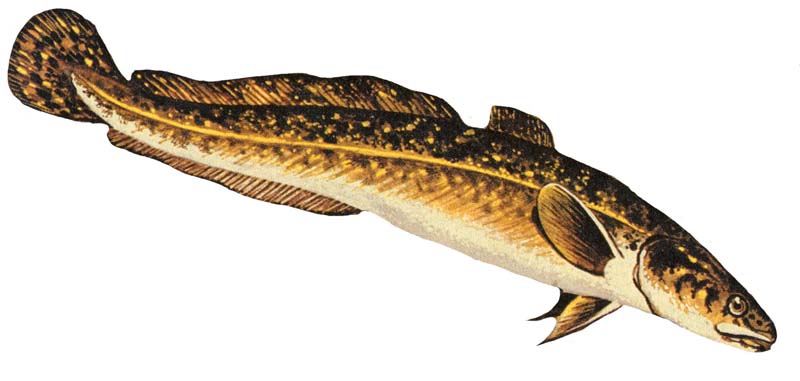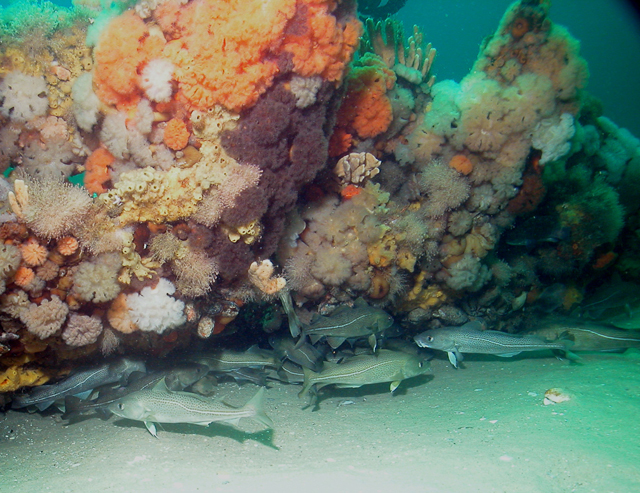|
Gadiform
Gadiformes are an order of ray-finned fish, also called the Anacanthini, that includes the cod. Many major food fish are in this order. They are found in marine waters throughout the world and the vast majority of the species are found in temperate or colder regions (tropical species are typically deep-water). A few species may enter estuaries but only one, the burbot (''Lota lota''), is a freshwater fish. Common characteristics include the positioning of the pelvic fins (if present), below or in front of the pectoral fins. Gadiformes are physoclists, which means their swim bladders do not have a pneumatic duct. The fins are spineless. Gadiform fish range in size from the codlets, which may be as small as in adult length, to the Atlantic cod, ''Gadus morhua'', which reaches up to . Timeline of genera ImageSize = width:900px height:auto barincrement:15px PlotArea = left:10px bottom:50px top:10px right:50px Period = from:-145.5 till:10 TimeAxis = orientation:hori ... [...More Info...] [...Related Items...] OR: [Wikipedia] [Google] [Baidu] |
Burbot
The burbot (''Lota lota'') is the only gadiform (cod-like) freshwater fish Freshwater fish are those that spend some or all of their lives in fresh water, such as rivers and lakes, with a salinity of less than 1.05%. These environments differ from marine conditions in many ways, especially the difference in levels of .... It is also known as bubbot, mariah, loche, cusk, freshwater cod, freshwater ling, freshwater cusk, the lawyer, coney-fish, lingcod, and eelpout. The species is closely related to the marine common ling and the cusk (fish), cusk. It is the monotypic, only member of the genus ''Lota''. For some time of the year, the burbot lives under ice, and it requires frigid temperatures to breed. Etymology The name burbot comes from the Latin word ''barba'', meaning beard, referring to its single chin whisker, or barbel (anatomy), barbel. Its generic and specific names, ''Lota lota'', comes from the old French ''lotte'' fish, which is also named "barbot" in Old French. ... [...More Info...] [...Related Items...] OR: [Wikipedia] [Google] [Baidu] |
Gadidae
The Gadidae are a family of marine fish, included in the order Gadiformes, known as the cods, codfishes, or true cods. It contains several commercially important fishes, including the cod, haddock, whiting, and pollock. Most gadid species are found in temperate waters of the Northern Hemisphere, but several range into subtropical, subarctic, and Arctic oceans, and a single (southern blue whiting) is found in the Southern Hemisphere. They are generally medium-sized fish, and are distinguished by the presence of three dorsal fins on the back and two anal fins on the underside. Most species have barbels on their chins, which they use while browsing on the sea floor. Gadids are carnivorous, feeding on smaller fish and crustaceans. Gadids are highly prolific, producing several million eggs at each spawning. This contributes to their high population numbers, which, in turn, makes commercial fishing relatively easy. Concepts differ about the contents of the family Gadidae. The syste ... [...More Info...] [...Related Items...] OR: [Wikipedia] [Google] [Baidu] |
Melanonidae
''Melanonus'' is a genus of gadiform fishes containing just two species of cod-like marine fishes. This is the only genus in the family Melanonidae. Both species are small fish, no more than in length, and are black in colour. They live in the midwaters of the Atlantic, Pacific and Indian Oceans, well away from coasts. Species The currently recognized species in this genus are: * '' Melanonus gracilis'' Günther, 1878 (pelagic cod) * '' Melanonus zugmayeri'' Norman Norman or Normans may refer to: Ethnic and cultural identity * The Normans, a people partly descended from Norse Vikings who settled in the territory of Normandy in France in the 10th and 11th centuries ** People or things connected with the Norm ..., 1930 (arrowtail) References Melanonidae Taxa named by Albert Günther {{Gadiformes-stub ... [...More Info...] [...Related Items...] OR: [Wikipedia] [Google] [Baidu] |
Gadus Morhua
The Atlantic cod (''Gadus morhua'') is a benthopelagic fish of the family Gadidae, widely consumed by humans. It is also commercially known as cod or codling.''Atlantic Cod'' . Seafood Portal. Dry cod may be prepared as unsalted stockfish,''Oxford English Dictionary'', 3rd ed. "milwell, ''n.''" Oxford University Press (Oxford), 2002.''Oxford English Dictionary'', 1st ed. "stock-fish , 'stockfish, ''n.''" Oxford University Press (Oxford), 1917. and as cured |
Late Cretaceous
The Late Cretaceous (100.5–66 Ma) is the younger of two epochs into which the Cretaceous Period is divided in the geologic time scale. Rock strata from this epoch form the Upper Cretaceous Series. The Cretaceous is named after ''creta'', the Latin word for the white limestone known as chalk. The chalk of northern France and the white cliffs of south-eastern England date from the Cretaceous Period. Climate During the Late Cretaceous, the climate was warmer than present, although throughout the period a cooling trend is evident. The tropics became restricted to equatorial regions and northern latitudes experienced markedly more seasonal climatic conditions. Geography Due to plate tectonics, the Americas were gradually moving westward, causing the Atlantic Ocean to expand. The Western Interior Seaway divided North America into eastern and western halves; Appalachia and Laramidia. India maintained a northward course towards Asia. In the Southern Hemisphere, Australia and Ant ... [...More Info...] [...Related Items...] OR: [Wikipedia] [Google] [Baidu] |
Pneumatic Duct
The swim bladder, gas bladder, fish maw, or air bladder is an internal gas-filled organ that contributes to the ability of many bony fish (but not cartilaginous fish) to control their buoyancy, and thus to stay at their current water depth without having to expend energy in swimming. Also, the dorsal position of the swim bladder means the center of mass is below the center of volume, allowing it to act as a stabilizing agent. Additionally, the swim bladder functions as a resonating chamber, to produce or receive sound. The swim bladder is evolutionarily homologous to the lungs. Charles Darwin remarked upon this in ''On the Origin of Species''.Darwin, Charles (1859''Origin of Species''Page 190, reprinted 1872 by D. Appleton. Darwin reasoned that the lung in air-breathing vertebrates had derived from a more primitive swim bladder. In the embryonic stages, some species, such as redlip blenny, have lost the swim bladder again, mostly bottom dwellers like the weather fish. Ot ... [...More Info...] [...Related Items...] OR: [Wikipedia] [Google] [Baidu] |
Codlet
Codlets are a family, Bregmacerotidae, of cod-like fishes, containing the single genus ''Bregmaceros'' found in tropical and subtropical waters throughout the world. They are very small fishes and even the largest, ''B. lanceolatus'', reaches only in length. Etymology Their scientific name is from Greek ''bregma'' meaning the top of the head, and ''keras'' meaning "horn"; this refers to their occipital ray (a spine emerging from the top of the head). Fossil record Fossils of ''Bregmaceros'' are found from the Eocene to the Quaternary (age range: from 37.2 to 0.0 million years ago.). They are known from various localities in Europe, North America and South America. Species Currently, 14 species in this genus are recognized: * ''Bregmaceros arabicus'' D'Ancona & Cavinato, 1965 * ''Bregmaceros atlanticus'' Goode & Bean, 1886 (antenna codlet) * ''Bregmaceros bathymaster'' D. S. Jordan & Bollman, 1890 (codlet) * ''Bregmaceros cantori'' Milliken & Houde, 1984 (striped c ... [...More Info...] [...Related Items...] OR: [Wikipedia] [Google] [Baidu] |
Atlantic Cod
The Atlantic cod (''Gadus morhua'') is a benthopelagic fish of the family Gadidae, widely consumed by humans. It is also commercially known as cod or codling.''Atlantic Cod'' . Seafood Portal. Dry cod may be prepared as unsalted stockfish,''Oxford English Dictionary'', 3rd ed. "milwell, ''n.''" Oxford University Press (Oxford), 2002.''Oxford English Dictionary'', 1st ed. "stock-fish , 'stockfish, ''n.''" Oxford University Press (Oxford), 1917. and as cured |
Early Cretaceous
The Early Cretaceous ( geochronological name) or the Lower Cretaceous (chronostratigraphic name), is the earlier or lower of the two major divisions of the Cretaceous. It is usually considered to stretch from 145 Ma to 100.5 Ma. Geology Proposals for the exact age of the Barremian-Aptian boundary ranged from 126 to 117 Ma until recently (as of 2019), but based on drillholes in Svalbard the defining early Aptian Oceanic Anoxic Event 1a (OAE1a) was carbon isotope dated to 123.1±0.3 Ma, limiting the possible range for the boundary to c. 122–121 Ma. There is a possible link between this anoxic event and a series of Early Cretaceous large igneous provinces (LIP). The Ontong Java-Manihiki-Hikurangi large igneous province, emplaced in the South Pacific at c. 120 Ma, is by far the largest LIP in Earth's history. The Ontong Java Plateau today covers an area of 1,860,000 km2. In the Indian Ocean another LIP began to form at c. 120 Ma, the Kerguelen P ... [...More Info...] [...Related Items...] OR: [Wikipedia] [Google] [Baidu] |
Eocene
The Eocene ( ) Epoch is a geological epoch (geology), epoch that lasted from about 56 to 33.9 million years ago (mya). It is the second epoch of the Paleogene Period (geology), Period in the modern Cenozoic Era (geology), Era. The name ''Eocene'' comes from the Ancient Greek (''ēṓs'', "dawn") and (''kainós'', "new") and refers to the "dawn" of modern ('new') fauna that appeared during the epoch. The Eocene spans the time from the end of the Paleocene Epoch to the beginning of the Oligocene Epoch. The start of the Eocene is marked by a brief period in which the concentration of the carbon isotope Carbon-13, 13C in the atmosphere was exceptionally low in comparison with the more common isotope Carbon-12, 12C. The end is set at a major extinction event called the ''Grande Coupure'' (the "Great Break" in continuity) or the Eocene–Oligocene extinction event, which may be related to the impact of one or more large bolides in Popigai impact structure, Siberia and in what is now ... [...More Info...] [...Related Items...] OR: [Wikipedia] [Google] [Baidu] |
Paleocene
The Paleocene, ( ) or Palaeocene, is a geological epoch (geology), epoch that lasted from about 66 to 56 mya (unit), million years ago (mya). It is the first epoch of the Paleogene Period (geology), Period in the modern Cenozoic Era (geology), Era. The name is a combination of the Ancient Greek ''palaiós'' meaning "old" and the Eocene Epoch (which succeeds the Paleocene), translating to "the old part of the Eocene". The epoch is bracketed by two major events in Earth's history. The K–Pg extinction event, brought on by Chicxulub impact, an asteroid impact and possibly volcanism, marked the beginning of the Paleocene and killed off 75% of living species, most famously the non-avian dinosaurs. The end of the epoch was marked by the Paleocene–Eocene Thermal Maximum (PETM), which was a major climatic event wherein about 2,500–4,500 gigatons of carbon were released into the atmosphere and ocean systems, causing a spike in global temperatures and ocean acidification. In the Pal ... [...More Info...] [...Related Items...] OR: [Wikipedia] [Google] [Baidu] |
Physoclist
Physoclisti are, collectively, fishes that lack a connection between the gas bladder and the alimentary canal, with the bladder serving only as a buoyancy organ. Addition and removal of the gases from the gas bladder in such physoclistous fishes occurs through specialised structures called the gas gland and ovale respectively. The pneumatic duct that connects the gut and gas bladder is present in the embryos of these fish but it is lost during development. This anatomical state (the physoclistous condition) is believed to be evolutionarily derived from the ancestral physostomous state. Some fishes, such as eels, are anatomically physostomous, but their gas bladders function similar to those of physoclists. See also * Physostome Physostomes are fishes that have a pneumatic duct connecting the gas bladder to the alimentary canal. This allows the gas bladder to be filled or emptied via the mouth. This not only allows the fish to fill their bladder by gulping air, but also ... ... [...More Info...] [...Related Items...] OR: [Wikipedia] [Google] [Baidu] |




.png)

